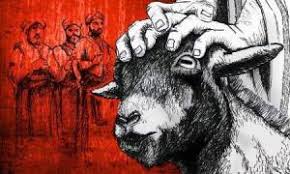The Insufficiency of the Former Sacrifices
9: 8-10
The insufficiency of the former sacrifices DIG: How was worship during the Dispensation of Torah limited? When was the first time the righteous of the TaNaKh could have full access to God? What did not happen in the Most Holy Place? Why were their gifts and sacrifices not able to clear their consciences? Why was the person sacrificing never freed from the feeling of guilt?
REFLECT: When you feel guilty, how do you try to clear your conscience? What is the difference between the internal faith and the external faith in your life? Is there any difference? Should there be any difference?

The tabernacle was temporary: Because the high priest (Hebrew: cohen hagadol) was the only one who could enter the Most Holy Place once a year, the Ruach Ha’Kodesh was showing us that the way into it had not yet been disclosed as long as earthly Tabernacle was functioning (9:8). The Levitical priesthood was unable to provide a way of access to God because the Most Holy Place was limited to the high priest. This temporary system was meant to prove that without a Redeemer, without the Messiah, without a Savior, there is no access to YHVH. The Ruach Ha’Kodesh was teaching the impossibility of access to ADONAI without a perfect Priest, a perfect Sacrifice, and a perfect Covenant. By allowing the people to go no farther than the outer court, God was illustrating that through the Levitical system there was no access to Him, only symbolic access through the high priest.222
After Messiah’s death on the cross, thus fulfilling the Levitical priestly sacrifices, the curtain of the Temple was torn in two from top to bottom (see the commentary on The Life of Christ Lw – Accompanying Signs of Jesus’ Death). This was God’s object lesson to the Aaronic priesthood that its ministry was over with, that the Tabernacle (and then the Temple later on) was to be closed, and that a new Priest had arisen after the order of Melchizedek. But Isra’el, in her apostasy, repaired the veil and kept on offering sacrifices until Ha’Shem, in His wrath, sent Rome to destroy Yerushalayim and scatter His people to the ends of the Roman Empire (see the commentary on The Life of Christ Mt – The Destruction of Jerusalem and the Temple on Tisha B’Av in 70 AD).
The way into the Holiest of all, into heaven itself and into the presence of ADONAI, had been opened at the cross. When God tore the veil in two from top to bottom (Matthew 27:51), God made a way for all who follow Yeshua as their High Priest to enter the Most Holy Place. They could enter thru the sacrifice of the true High Priest, the Messiah, who entered the heavenly Most Holy Place – showing the earthly one was to be a thing of the past.223 Therefore, since we have a great high priest who has gone through the heavens, Jesus the Son of God, let us hold firmly to the faith we profess. (Hebrews 4:14).
The tabernacle ministry was external, not internal: The Tabernacle was a symbol for the present time, indicating that the gifts and sacrifices being offered there were not able to clear the conscience of the worshiper (9:9). Even with all the ceremonies and rituals, perfect cleansing from sin could not be accomplished under the Levitical priesthood. The particular imperfection mentioned here is that of conscience. The Levitical system was imperfect in every way, but the author selected only certain aspects of it to make his point.
The word symbol is the translation of the Greek parabole, which means to place beside to explain a spiritual truth. The Levitical priesthood was only a parable, an object lesson used to explain a spiritual truth. The Levitical sacrifices were never meant to permanently cleanse from sin. The conscience of the person sacrificing was never freed from the feeling of guilt because the guilt itself was never permanently removed. The Levitical ritual, as such, did not touch the conscience. No ritual in itself ever does. As a result, the Israelite could never fully have a clear conscience, a deep abiding sense of forgiveness.
Then the writer points out the basis for the weakness of the Levitical system. They are only a matter of food and drink and various ceremonial washings – external regulations applying until the time of restoration through Jesus Christ (9:10 CJB). The Levitical sacrifices were dependent upon the strength of the flesh. It was only external, and therefore, temporary. As of now, it has been nearly two thousand years since the last sacrifice was made in the Temple. The word reshape is from diorthosis, which means to make straight, to make things right, or to reform. Only the death, resurrection and ascension of Yeshua Messiah restores the path to heaven. The Levitical sacrifices were never meant to permanently make things right between the Israelites and God. They had to be repeated day after day, year after year. The final sacrifice came with the establishment of the B’rit Chadashah. With it, the time of restoration had arrived. When Christ shed His blood on the cross, however, the restoration came internally, not merely externally. Therefore, if anyone is in Christ, the new creation has come: The old has gone, the new is here (Second Corinthians 5:17)!
The Tabernacle and its sacrifices were significant and meaningful. But they were limited, imperfect and temporary. They pictured Messiah, but they could not do the work of Christ. Part of their purpose, in fact was to show Isra’el that they were only pictures of better things to come. They not only pictured the Lord but also their own built-in inadequacies.224



Leave A Comment